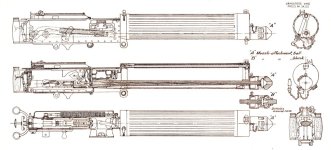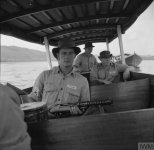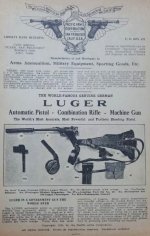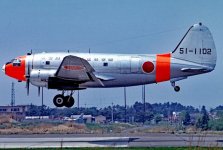You are using an out of date browser. It may not display this or other websites correctly.
You should upgrade or use an alternative browser.
You should upgrade or use an alternative browser.
Picture of the day
- Thread starter jwhc
- Start date
fat tony
CGN Ultra frequent flyer
A survivor of a place of destruction, The Battle of Cologne, receives well overdue, greatly deserved thanks.
https://www.lehighvalleylive.com/ne...e-allentown-veteran-gets-his-bronze-star.html
He and his fellow soldiers fought their way through an apocalyptic inferno in Cologne, 1945, bearing witness to untold horror and extreme violence.

Clarence Smoyer in 2019
RIP
https://www.lehighvalleylive.com/ne...n-to-be-buried-with-full-military-honors.html
https://www.lehighvalleylive.com/ne...e-allentown-veteran-gets-his-bronze-star.html
He and his fellow soldiers fought their way through an apocalyptic inferno in Cologne, 1945, bearing witness to untold horror and extreme violence.

Clarence Smoyer in 2019
RIP
https://www.lehighvalleylive.com/ne...n-to-be-buried-with-full-military-honors.html
Last edited:
Dark Alley Dan
CGN Ultra frequent flyer
- Location
- Darkest Edmonton
Consolidated PBY Catalina?Steely-eyed Sgt. behind matching Vickers. Hell of an office. Love the stenciling below the blister.
View attachment 900595
fat tony
CGN Ultra frequent flyer
A Canso.Consolidated PBY Catalina?
https://www.warplane.com/aircraft/collection/details.aspx?aircraftId=11
ACAM has either a Canso or Catalina they are restoring.
https://acamuseum.ca/on-display/aircraft-collection/pby-5a-catalina-canso/
From what the info signs at the museum said, it was recovered from the Labrador bush in (?)1987. It was originally a USN Catalina which was used in the Carribean for the commercial trade, then sold to Eastern Provincial Airways.
Last edited:
Dark Alley Dan
CGN Ultra frequent flyer
- Location
- Darkest Edmonton
Wanted: time machine. Will pay stupid price.
Reckon I can make the money back with a few cases of $55.00 Mosins...
Reckon I can make the money back with a few cases of $55.00 Mosins...
Donny Fenn1
CGN Ultra frequent flyer
- Location
- East Kootenays
f@$k that if I'm going back I'm buying everyWanted: time machine. Will pay stupid price.
Reckon I can make the money back with a few cases of $55.00 Mosins...
No. 4 MK I (T) that I can find
Dark Alley Dan
CGN Ultra frequent flyer
- Location
- Darkest Edmonton
The post-war French air force had some interesting birds...







Dark Alley Dan
CGN Ultra frequent flyer
- Location
- Darkest Edmonton
Dark Alley Dan
CGN Ultra frequent flyer
- Location
- Darkest Edmonton
Dark Alley Dan
CGN Ultra frequent flyer
- Location
- Darkest Edmonton
They certainly do. In fact, they have two operating - C-FAVO and C-GTPO. C-FAVO has had quite the history: https://www.aerialvisuals.ca/AirframeDossier.php?Serial=8523

Apparently, the C46 was a problem child. Kinda surprising that Buffalo has done so well with theirs, but I suppose eighty years of product evolution will do that. This from Wikipedia:

Apparently, the C46 was a problem child. Kinda surprising that Buffalo has done so well with theirs, but I suppose eighty years of product evolution will do that. This from Wikipedia:
Despite its obvious and valuable utility, the C-46 remained a maintenance nightmare throughout its AAF career. The official history of the Army Air Forces summarized its shortcomings,
During the war years, the C-46 was noted for an abnormal number of unexplained airborne explosions (31 between May 1943 and May 1945) that were initially attributed to various causes. In particular, the fuel system, which was quickly designed, then modified for the new, thirstier Pratt & Whitney engines, was criticized. The cause of the explosions was eventually traced to pooled gasoline from small leaks in the tanks and fuel system, combined with a spark, usually originating from open-contact electrical components. Though many service aircraft suffered small fuel leaks in use, the C-46's wings were unvented; if a leak occurred, the gasoline had nowhere to drain, but rather pooled at the wing root. Any spark or fire could set off an explosion. After the war, all C-46 aircraft received a wing vent modification to vent pooled gasoline, and an explosion-proof fuel booster pump was installed with shielded electrical selector switches in lieu of the open-contact type used originally.But from first to last, the Commando remained a headache. It could be kept flying only at the cost of thousands of extra man-hours for maintenance and modification. Although Curtiss-Wright reported the accumulation by November 1943 of the astounding total of 721 required changes in production models, the plane continued to be what maintenance crews around the world aptly described as a "plumber's nightmare". Worse still, the plane was a killer. In the experienced hands of Eastern Air Lines and along a route that provided more favorable flying conditions than were confronted by military crews in Africa and on the Hump route into China, the plane did well enough. Indeed, Eastern Air Lines lost only one C-46 in more than two years of operation. But among the ATC pilots the Commando was known, with good reason, as the "flying coffin". From May 1943 to March 1945, Air Transport Command received reports of thirty-one instances in which C-46s caught fire or exploded in the air. Still others were listed merely as "missing in flight", and it is a safe assumption that many of these exploded, went down in flames, or crashed as the result of vapor lock, carburetor icing, or other defects.[16]
Last edited:
Dark Alley Dan
CGN Ultra frequent flyer
- Location
- Darkest Edmonton




















































































